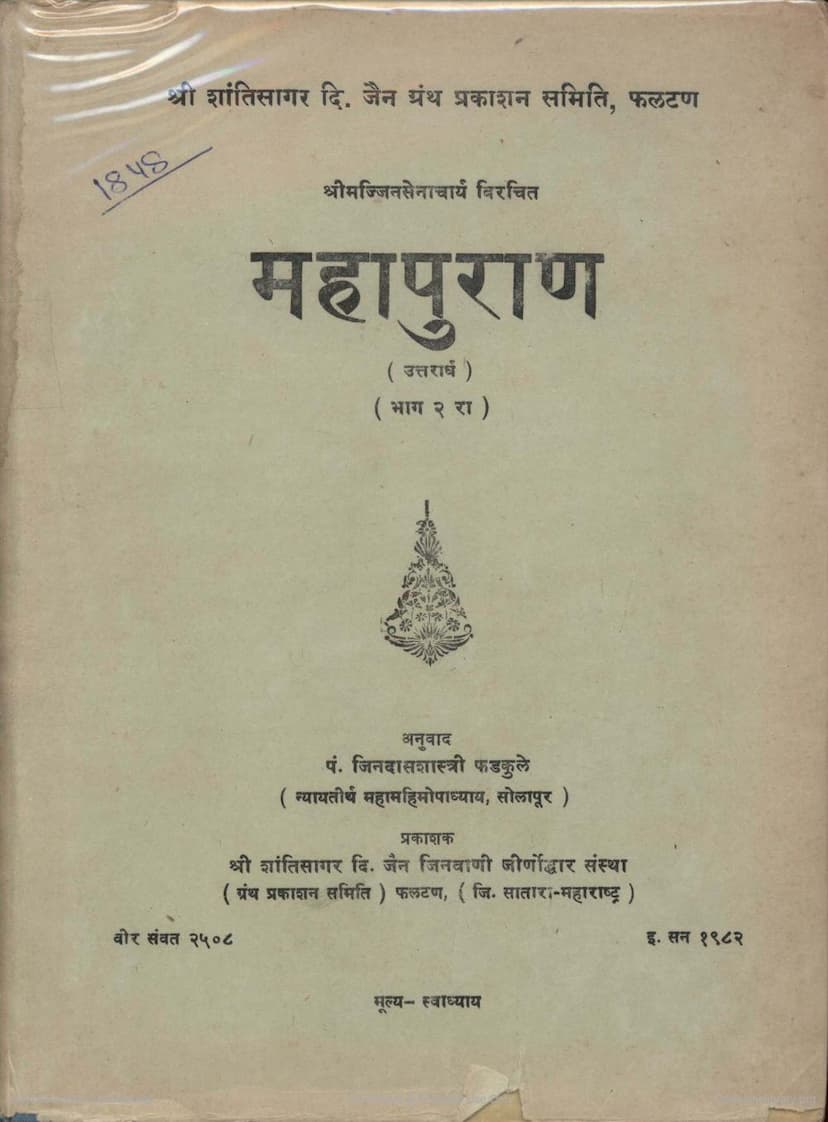Mahapurana Part 2
Added to library: September 2, 2025

Summary
Here's a comprehensive summary of the provided Jain text, Mahapurana Part 2, based on the excerpt you've shared:
Mahapurana Part 2: A Summary
This text, the Uttarardha (later part) of the Mahapurana, authored by Jinsenacharya and translated by Jindas Shastri, is a profound exposition of Jain principles and narratives. Published by Shantisagar Digambar Jain Jinwani Jirnoddhar Sanstha, it delves deeply into the lives and teachings of Tirthankaras, particularly focusing on the spiritual journey and the nature of the liberated soul.
The provided pages primarily cover the 25th chapter (Paryavsan) and delve into the Pravachana (divine discourse) of Bhagwan Rishabhanatha. The discourse is presented as an elaborate hymn of praise by Saudharma Indra, highlighting the multifaceted virtues and divine attributes of Bhagwan Rishabhanatha.
Key Themes and Content:
-
Exalted Praise of Bhagwan Rishabhanatha: The central theme is the detailed and extensive praise of Bhagwan Rishabhanatha's divine qualities. The text enumerates numerous epithets, each describing a specific aspect of his perfection, omniscience, compassion, and spiritual power. These epithets cover:
- Physical Perfection: His divine body, its auspicious marks, its radiant aura.
- Spiritual Accomplishments: His attainment of Kevala Jnana (omniscience), his victory over passions and karma, his mastery over the senses.
- Divine Attributes: His infinite knowledge, vision, bliss, and power, his renunciation, his role as a guide and savior.
- Symbolic Meanings: Many names highlight his resemblance to various divine entities or concepts, symbolizing his universal significance.
-
The Samavsara Assembly: The text describes the Samavsarana, the divine assembly where the Tirthankara delivers his teachings. This sacred space is depicted with meticulous detail:
- Divine Aura: The Samavsarana is adorned with precious jewels, divine trees (Kalpavriksha), pleasant gardens, and filled with celestial music and fragrances.
- Presence of Beings: It is attended by gods (Devas), Vidyadharas, Gandharvas, Kinnaras, and a multitude of humans and animals, all drawn by the Tirthankara's divine presence and teachings.
- Symbolic Elements: The description includes the divine umbrella, chowries, the Ashoka tree, and other auspicious symbols that surround the Tirthankara.
-
The Nature of True Virtues: The text emphasizes the superiority of inner qualities over external appearances. Bhagwan Rishabhanatha's detachment from worldly possessions, his control over his senses, and his inherent purity are highlighted as the true sources of his glory, surpassing any external adornments.
-
The Path to Liberation: Through the praise of the Tirthankara's attributes, the text implicitly guides the reader towards the Jain path of liberation. The Tirthankara's life and teachings are presented as the ultimate example of how to overcome karma and achieve Moksha.
-
The Power of Devotion: The text underscores the importance of devotion (Bhakti) in understanding and approaching the divine. Saudharma Indra's profound devotion is the catalyst for this elaborate hymn.
Structure and Style:
- Hymn of Praise: The chapter is structured as an extended hymn or Stotra, with the narrator (likely the Tirthankara himself, or a narrator describing him) praising the Tirthankara's numerous names and attributes.
- Descriptive Language: The language is highly descriptive and poetic, employing rich imagery and similes to convey the Tirthankara's magnificence.
- Comprehensive Listing: A significant portion is dedicated to listing and explaining the meaning behind hundreds of names and attributes, painting a comprehensive picture of the Tirthankara's perfection.
In essence, this section of the Mahapurana serves as a devotional tribute and a profound spiritual lesson, illustrating the path to ultimate liberation through the perfect example of Bhagwan Rishabhanatha's life and teachings. It aims to inspire reverence and understanding of the highest spiritual states achievable in Jainism.